|
Posted 9/16/24
PREVENTION THROUGH PREEMPTION
Expanding the scope of policing beyond making arrests

For Police Issues by Julius (Jay) Wachtel. On the morning of Sept. 4, 2024 Colt Gray, a 14-year old student, walked into Apalachee High School in Winder, Georgia. An “AR-style” rifle was concealed in his backpack. He went to class but soon walked out. And on his return he opened fire, killing two students and two teachers and wounding nine others.
Colt promptly surrendered. Details about what he did, and why, continue to emerge. (For the AP’s extensive, frequently updated account, click here.) How this tragedy might have been prevented is getting a lot of attention. Colt reportedly alerted his mother that he had evil intentions. Alas, her call to the school apparently came too late. Physical security measures also seemed lacking. In our gun-saturated land, metal detectors and backpack searches may no longer be “optional”. Here, though, our focus is on the cops. Could authorities have taken life-saving, proactive steps months, even years earlier? Did they have the necessary tools? And, most importantly, the right mission?
im committing a mass shooting,
and im waiting a good 2-3 years
im on the edge of a lgbtq massacre
In May, 2023 the FBI received “several anonymous tips about online threats to commit a school shooting at an unidentified location and time.” These two examples exemplify what was being posted on a Discord account under the name of “Lanza” (the notorious Sandy Hook killer, but in Russian.) An email address connected with the account was linked to then-13-year-old Colt Gray, and the FBI passed it all on to the Jackson County sheriff.
Click here for the complete collection of gun control essays
 Colt and his father, Colin, were promptly visited by two deputies. That visit was in part captured on video (click here). Throughout its approx. 13-minute length, the deputy who conducted the interview (his companion took the video) used a mild tone and was careful not to offend. Attributing the visit to “Lanza’s” posts, he insisted that he and his partner were just doing their job. “I hate this…I feel pretty bad about this…” He also downplayed the matter’s urgency. “I don’t know how old this information is….” Colt and his father, Colin, were promptly visited by two deputies. That visit was in part captured on video (click here). Throughout its approx. 13-minute length, the deputy who conducted the interview (his companion took the video) used a mild tone and was careful not to offend. Attributing the visit to “Lanza’s” posts, he insisted that he and his partner were just doing their job. “I hate this…I feel pretty bad about this…” He also downplayed the matter’s urgency. “I don’t know how old this information is….”
Colt’s father, with whom the deputy first spoke, confirmed that he kept hunting guns at home, but that his son could only access them under supervision. Colin proudly said that Colt did “a lot of hunting” and had “shot his first deer this year.” But he also mentioned that Colt was “getting picked on in school.” Colt soon joined in. He and his father denied any knowledge of the threats. Colt said he left Discord because his account was hacked. He conceded being bullied, and said that he was being helped by a school counselor.
Although the deputy’s tenor remained compassionate and low-key, he ultimately conveyed some mixed feelings about Colt’s denials. “I gotta take you at your word. And I hope you’re being honest with me…I’m not saying you’re lying…but it’s not unusual for people to lie to me.”
Video aside, the deputies’ written report offered a disturbing picture of the Gray household. Nine months earlier, in August 2022, the family, comprised of Colin, his wife Marcee, Colt and two younger siblings, was formally evicted from their home. Deputies participated in the process and took ammunition and an assortment of weapons including “a black AR-15 rifle with a scope” for safekeeping. These items were later returned to the father.
Colin and Marcee separated. She took the two youngest, and Colin and Colt moved to the residence where they were interviewed. Marcee went on to rack up a string of arrests for drugs, family violence and battery. After serving a brief jail term, she was required to attend a “family violence intervention program” and was prohibited from contacting her husband.
Had the deputies taken prompt and decisive action after meeting with Mr. Gray and his son, four innocents might still be alive. So why didn’t they? A few hours after the massacre the FBI released an official statement that deemed Colt’s reported connection to the threats as “inconsistent” and insufficient to justify an arrest. Here’s an extract:
…The father stated he had hunting guns in the house, but the subject did not have unsupervised access to them. The subject denied making the threats online. Jackson County alerted local schools for continued monitoring of the subject…At that time, there was no probable cause for arrest or to take any additional law enforcement action on the local, state, or federal levels.
What was needed? Here’s Georgia’s law on “terroristic threats” (GA Code § 16-11-37):
(1) A person commits the offense of a terroristic threat when he or she threatens to: (A) Commit any crime of violence; (B) Release any hazardous substance; or (C) Burn or damage property.
(2) Such terroristic threat shall be made: (A) With the purpose of terrorizing another; (B) With the purpose of causing the evacuation of a building, place of assembly, or facility of public transportation; (C) With the purpose of otherwise causing serious public inconvenience; or (D) In reckless disregard of the risk of causing the terror, evacuation, or inconvenience described in subparagraph (A), (B), or (C) of this paragraph.
(3) No person shall be convicted under this subsection on the uncorroborated testimony of the party to whom the threat is communicated. Terroristic threats are misdemeanors unless they call for someone (implicitly, a specific someone) to be killed, in which case they are felonies.
There’s no disputing that the Discord posts reviewed by the Washington Post meet Georgia’s legal definition of “terroristic threat.” What the FBI and sheriff’s office said they found lacking, though, was the “who.”
As one would expect, the Apalachee High School shooting has stirred a great deal of critical retrospection. Authorities are now facing severe criticism for not using subpoenas and other means to probe Colt’s supposedly vile online behavior.
Still, even critics concede that invoking the power of the criminal law is no simple matter. When the deputies visited there had not been a shooting, and the one crime that a 13-year old might have committed was likely to be deemed a misdemeanor. Georgia’s cops aren’t mandated or funded to chase wild geese.
Is anyone? Actually, yes. Twenty-one States (not including Georgia) have enacted “extreme risk” (aka “Red Flag”) laws. These enable authorities – and, often, family members and co-workers – to petition courts for orders directing police to seize guns that may be at imminent risk of misuse.
Red Flag laws provide agencies with the rationale and – equally importantly – the funding they might need to probe the personal histories of troubled souls. And Colt hardly needed a very deep dive. His extended family was well aware of the youth’s long-standing psychological issues. Annie Brown, his mother’s aunt, recently told The Washington Post that she had helped the child, who was chronically absent from school, enroll in a new middle school. Colt, she claimed, was “begging for help from everybody around him. The adults around him failed him.”
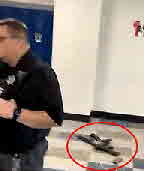 Colin obviously knew that he had a seriously troubled kid. But when the deputies showed up he conveyed the fiction that everything was well in hand. He conceded that Colt experienced “some problems” at middle school, but insisted that things had improved. Colin didn’t get into the details of his son’s mental health issues, and the deputies apparently didn’t ask. Indeed, Colt’s father had apparently fooled himself. In December 2023, about seven months after the deputies’ visit, he bought the AR-15 style rifle that was used in the massacre (crime scene photo on left) as a Christmas present for his son. Colin obviously knew that he had a seriously troubled kid. But when the deputies showed up he conveyed the fiction that everything was well in hand. He conceded that Colt experienced “some problems” at middle school, but insisted that things had improved. Colin didn’t get into the details of his son’s mental health issues, and the deputies apparently didn’t ask. Indeed, Colt’s father had apparently fooled himself. In December 2023, about seven months after the deputies’ visit, he bought the AR-15 style rifle that was used in the massacre (crime scene photo on left) as a Christmas present for his son.
In the end, it fell to Colt’s grandmother to go to Apalachee High School and ask for help. And they apparently came through. Colt was scheduled to start therapy one week before the shooting.
On September 6, 2024, father and son appeared in Barrow County Superior Court. Colt, who is being treated as an adult, was charged with four counts of murder. Moments later, the same judge charged his father with “four counts of involuntary manslaughter, two counts of second-degree murder and eight counts of cruelty to children.”
Might a Red Flag law have prevented four deaths, nine woundings, anticipated life-without-parole sentences for a father and son, and the hideous toll on families and friends? It’s possible. But even in Red Flag states, extreme risk protection orders require forewarning. And the will and resources to carry the process through. On August 21 a California senior opened fire in his home, wounding his mother and leaving two adult relatives dead. Police were twice called to the residence about the shooter’s behavior during the previous week. But officers didn’t think that 60-year old William Bushey posed an immediate threat. “He did not meet the criteria for an emergency psychiatric hold, so they left, leaving the family with resources.”
Be sure to check out our homepage and sign up for our newsletter
No, those “resources” didn’t include body armor.
And the slaughter inexorably continues. Two days after Apalachee, a dispute led a 16-year old to shoot and kill a 15-year old in a restroom at Joppatowne High School in Joppa, Maryland. Yes, that state has a Red Flag law, but there was apparently no forewarning. Clearly, to make a real difference one must restrict the availability of guns. Say, altogether prohibit their possession by youths. (Of course, that would get in the way of dads sharing a unique hobby.) Or require that firearms kept at home be stored under lock and key. (Of course, that could get in the way should an emergency arise.) Bottom line: in our ideologically-riven, gun-obsessed land, enforcing the laws that exist is difficult enough; the barrier to tightening things up may well be insurmountable. So we’ll keep doing what’s least controversial – say, going after ex-cons with guns and their shady suppliers, as your writer did during his ATF career – and leave the rest for another day.
That is, should there be another.
UPDATES (scroll)
5/16/25 Highly timely tip-offs recently enabled authorities to thwart school shootings in Texas and in California. Acting on a grandma’s tip, Texas police arrested Ashley Pardo for buying ammo and tactical gear for her 13-year old son, a deeply-disturbed boy long obsessed with school shootings. School officials recently questioned him after finding drawings setting out how a massacre at his middle school would happen. And a Tennessee online gamer’s tip led to the arrest of two boys, ages 14 and 15. Fans of Columbine, they were deeply immersed in plans to carry out a like massacre at their Northern California campus.
2/12/25 In Sept. 2024 Colt Gray, 14, used an AR-15 style rifle given to him by his father, Colin, to murder two fellow students and two teachers at Apalachee High School, Winder, Georgia. Colin knew that his son was deeply troubled but nonetheless gave him the gun as a Christmas present. That led to his being charged with 29 counts, including two of murder and two of manslaughter. On November 21 the father pled not guilty to all charges. And although survivors objected, a judge just released him on $500,000 bond. He will be staying at his sister’s home, 70 miles from Winder.
2/4/25 Six days after a 14-year old opened fire at Georgia’s Apalachee High School, a 14-year old Florida girl posted a threat to blow up her school. That led to her prompt arrest, followed by three weeks in detention. Like consequences quickly befell several other youths in Volusia County. “This is absolutely out of control, and it ends now,” said its Sheriff. According to the Washington Post, “at least 477 people — 90 percent of them students” were arrested across the U.S. for making threats during the two weeks after Apalachee. Like spurts in threats and arrests have also followed other school shootings.
1/30/25 Georgia legislators are mulling over bills that respond to the March 2024 Apalachee High School shooting, when 14-year old Colin Gray used his father’s assault rifle to kill two fellow students and two teachers. One would require that parents keep guns locked up and inaccessible to their kids. Another would help schools identify and “monitor” problematic youngsters even if they change school districts, as Colin did after he and his father were questioned by deputies over his threatening online posts.
10/18/24 Two counts of 2nd. degree murder and two counts of manslaughter. Those are among the twenty-nine counts returned by a grand jury against Colin Gray, the father of the Apalachee High School shooter. His fourteen-year old son, Colt Gray, who was charged as an adult, faces fifty-five counts, including four counts of murder and twenty-five counts of aggravated assault. Both are being held without bond. And it’s likely they will remain locked up for a very, very long time. Note: On November 21, 2024 Colin, the father, pled not guilty to all charges.
10/17/24 A preliminary hearing in the case against Colin Gray, the father of Apalachee High School shooter Colt Gray, is in progress. Testimony revealed that Colt Gray had posted a photo of Parkland High School mass murderer Nikolas Cruz in his room, and that his father had seen it and was told who it was. According to a State agent, Colt Gray prepared highly detailed written plans for the assault, including “a step-by-step checklist” and estimates of “casualty counts” by location.
9/26/24 A probe by the New York Times reveals that since the Sept. 4 shooting at Apalachee High School, “more than 700 children and teenagers” have been arrested for making threats against schools across the U.S. Ninety-eight attended schools in Apalachee’s home state of Georgia. While shootings on school campuses are fewer than in past years, the unusual scale and severity of the threats has greatly affected school operations. It’s also created a divide about whether arrests are the appropriate response.
9/23/24 Marcee Gray, the mother of 14-year old Apalachee High School shooter Colt Gray, has been charged with elder abuse for brutally assaulting her elderly mother last year. According to the indictment she became enraged when her mother refused to help her confront Colt’s father, from whom Marcee was estranged. So she strapped the elderly woman to a chair and left her immobilized for nearly a full day. Marcee Gray said that she called Colt’s school the morning of the shooting to warn them about her son.
|
Did you enjoy this post? Be sure to explore the homepage and topical index!
Home Top Permalink Print/Save Feedback
RELATED POSTS
Gun Massacres special topic Police and the Mentally Ill special topic
Kids With Guns Are We Helpless to Prevent Massacres? Red Flag at Half Mast (I) (II)
Posted 6/3/24, edited 3/21/25
KIDS WITH GUNS
Ready access and permissive laws create a daunting problem
For Police Issues by Julius (Jay) Wachtel. As our unimaginably conflicted Presidential campaign picks up steam, it’s probably inevitable that even the most gut-wrenching examples of America’s struggle with gun violence will be consigned to the back-burner. So when a married couple recently drew fifteen years in prison for their son’s vicious behavior, hardly anyone (other than his victims’ families, of course) seemed to notice.
In November 2021 15-year old Ethan Crumbley gunned down four classmates and wounded seven other persons at Michigan’s Oxford High School. One day earlier, a teacher had caught the youth searching for ammunition on his phone. His parents were informed. His mother later messaged her son “Lol. I’m not mad at you. You have to learn not to get caught.” That evening Ethan’s new Instagram post showed him holding the gun: “just got my new beauty today...I am become Death, the destroyer of worlds. See you tomorrow, Oxford.”
Click here for the complete collection of gun control essays
One hour before the massacre Ethan and his parents, Jennifer and James Crumbley, met with school staff about the son’s concerning behavior. They were shown one of Ethan’s posts. It depicted a gun, a bullet, a bleeding person, and these comments: “The thoughts won’t stop. Help me”, “Blood everywhere”, “My life is useless”, “The world is dead.” But the parents declined to take the boy home. Neither did anyone peer in Ethan’s backpack. It held the 9 mm. pistol that was bought four days earlier as an early “Christmas present.”
Last year Jennifer and James Crumbley were convicted at separate trials on four counts of voluntary manslaughter for recklessly furnishing the gun to their son. It didn’t help their cause that Ethan had accompanied his father to the gun store. Nor that his mother once posted an open letter on Twitter thanking newly-elected President Trump for, among other things, “allowing my right to bear arms [and] be protected if I show a home to someone with bad intentions.”
Ethan pled guilty to first-degree murder and terrorism in December 2023. He told the judge that “any sentence that they ask for, I ask that you do impose it on me”. Although seventeen, thus still not technically an “adult”, he drew life without parole. His parents will be eligible for release in ten years (click here for the Washington Post “deep read”.)
Families of the shooting victims sued school staff for failing to take preventive action. But on March 20, 2025 a Sixth Circuit panel rejected the claim that Oxford High in effect created the danger by staging a meeting that included the shooter, and insisting that the boy either get counseling or they’d bring in child protective services. So that’s where things presently stand.
Troubled youths often act out their demons at school. And if a gun’s readily available, so much the worse. We’ve covered a host of these tragedies. Here are the worst four:
- 1999 Columbine High School massacre (Columbine, Colorado). Two twelfth-grade students, one eighteen, the other seventeen, used assault-style pistols and shotguns acquired through friends to murder twelve students and a teacher and wound twenty-one others.
- 2012 Sandy Hook Elementary School massacre (Newtown, Connecticut). A twenty-year old former student killed his mother, then used her assault-style rifle and 9 mm. pistol to shoot his way into the school. He gunned down twenty children and six adult employees, then committed suicide. Police Issues post
- 2018 Marjorie Stoneman High School massacre (Parkland, Florida). A nineteen-year old former student used an AR-15 style rifle that he legally bought in a gun store in 2017 to murder fourteen students and three teachers. He was later arrested without incident. Police Issues post
- 2022 Robb Elementary School massacre (Uvalde, Texas). An eighteen-year old former student shot his grandmother in the face, then used an AR-15 style rifle that he legally bought (he left a second rifle in his vehicle) to murder nineteen students and two teachers and wound seventeen others. He was shot and killed by a SWAT team while still inside the school. Police Issues post
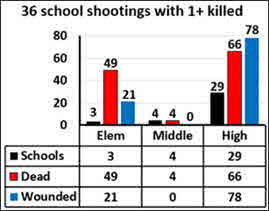 Here our objective is to explore the youthful misuse of guns, and particularly by younger teens. While we didn’t intend to focus on school shootings, these deplorable events helped us explore how children became murderous gunslingers. Using Wikipedia’s List of school shootings in the United States (2000–present), we selected all shootings at K-12 schools between 2012 and 2024 where the shooter was under 21 and killed at least one person. That yielded 36 episodes, one at each of three elementary schools, four middle schools, and 29 high schools. In all, 119 persons were killed and 99 were wounded. Here our objective is to explore the youthful misuse of guns, and particularly by younger teens. While we didn’t intend to focus on school shootings, these deplorable events helped us explore how children became murderous gunslingers. Using Wikipedia’s List of school shootings in the United States (2000–present), we selected all shootings at K-12 schools between 2012 and 2024 where the shooter was under 21 and killed at least one person. That yielded 36 episodes, one at each of three elementary schools, four middle schools, and 29 high schools. In all, 119 persons were killed and 99 were wounded.
There were two unique groups: thirty-two shootings with one to four persons killed other than the shooter, and four shootings with ten to twenty-six:

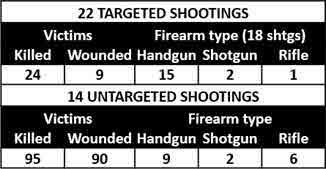 Shooter intent and gun type were key determinants of the human toll. Twenty-two episodes in the one-to-four killed group were “targeted” on specific antagonists, often someone who supposedly had bullied the shooter. (In a middle school shooting that involved three 13-year olds, the shooter was the bully, while his victim was a youth who was defending the child being bullied.) Handguns were used in nearly all targeted shootings. Per-shooting casualty counts were accordingly limited: twenty had one death, and two had two deaths each. In contrast, eight of the fourteen “untargeted” episodes, where shooters had no specific victim in mind, caused more than one fatality. Their greatly disproportionate overall toll is attributable to four episodes that involved long guns: the 2018 Santa Fe High School (TX) shooting, where a 17-year old armed with a handgun and shotgun took ten lives, and the massacres at Sandy Hook, Marjorie Stoneman and Robb Elementary, where rifles were used to murder sixty-four. Shooter intent and gun type were key determinants of the human toll. Twenty-two episodes in the one-to-four killed group were “targeted” on specific antagonists, often someone who supposedly had bullied the shooter. (In a middle school shooting that involved three 13-year olds, the shooter was the bully, while his victim was a youth who was defending the child being bullied.) Handguns were used in nearly all targeted shootings. Per-shooting casualty counts were accordingly limited: twenty had one death, and two had two deaths each. In contrast, eight of the fourteen “untargeted” episodes, where shooters had no specific victim in mind, caused more than one fatality. Their greatly disproportionate overall toll is attributable to four episodes that involved long guns: the 2018 Santa Fe High School (TX) shooting, where a 17-year old armed with a handgun and shotgun took ten lives, and the massacres at Sandy Hook, Marjorie Stoneman and Robb Elementary, where rifles were used to murder sixty-four.
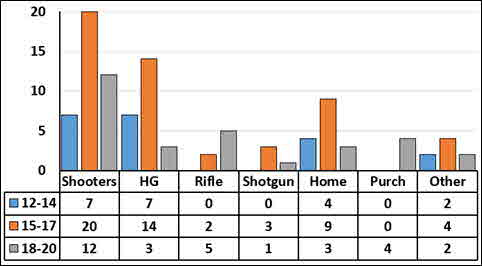
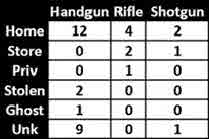 Our thirty-six episodes had forty shooters. Thirty-nine were between the ages of twelve and twenty; one was twenty-one. Handguns were by far their most common weapon. After all, they’re easy to conceal, and firepower isn’t as much at issue when there is a specific “target” in mind. Handguns were also the only firearms used by the younger shooters. Unable to legally buy a gun of any kind, they usually turned to weapons that belonged to adult family members and were kept at home. Our thirty-six episodes had forty shooters. Thirty-nine were between the ages of twelve and twenty; one was twenty-one. Handguns were by far their most common weapon. After all, they’re easy to conceal, and firepower isn’t as much at issue when there is a specific “target” in mind. Handguns were also the only firearms used by the younger shooters. Unable to legally buy a gun of any kind, they usually turned to weapons that belonged to adult family members and were kept at home.
In our lead-off example a fifteen-year old’s parents were imprisoned over the lethal consequences of gifting a pistol to their deeply troubled son. News accounts don’t suggest that family members purposely granted such ready access to any of the other young shooters. Two of their handguns actually came from other teens’ homes. In a 2022 Seattle-area high school shooting a 14-year old boy used a pistol that another 14-year old supposedly stole from his father’s handbag. Six years earlier, a 15-year old Arizona high school student borrowed a handgun from a classmate who brought it from home, supposedly without permission. After the killing, the shooter committed suicide. He was one of ten in our sample to do so.
 Rifles were of mixed origin. Two massacres – at Marjorie Stoneman and Robb Elementary – were committed with rifles that shooters legally purchased at gun stores. The rifle used at Sandy Hook belonged to the youth’s mother. He took it, along with a handgun, after shooting her dead. We’ve often commented on the killing power of assault rifles (see “Ban the Damned Things!”). Here their effects proved truly devastating. Used on only six occasions, they accounted for more than half the total deaths and nearly half the woundings. Rifles were of mixed origin. Two massacres – at Marjorie Stoneman and Robb Elementary – were committed with rifles that shooters legally purchased at gun stores. The rifle used at Sandy Hook belonged to the youth’s mother. He took it, along with a handgun, after shooting her dead. We’ve often commented on the killing power of assault rifles (see “Ban the Damned Things!”). Here their effects proved truly devastating. Used on only six occasions, they accounted for more than half the total deaths and nearly half the woundings.
Schools continue to be beset by armed youths. On May 1, 2024 Mt. Horeb, Wisconsin police shot and killed a 14-year old who was about to enter his middle school while armed with a rifle. He reportedly pointed the weapon – it turned out to be a Ruger .177 caliber pellet rifle – at responding officers and didn’t drop it when ordered. His disturbing online chatter (he posted “my last morning” earlier that day) revealed a fascination with guns.
Two days later, a 17-year old Washington D.C. high school student was wounded by a bullet that pierced her classroom. Two students, ages seventeen and eighteen, were arrested for “assault with a dangerous weapon, carrying a pistol without a license and endangerment with a firearm.”
Might lawmaking offer a solution? Not according to Iowa’s Governor:
This was a horrible tragedy. It’s certainly nothing that any governor wants to wake up to in the morning and hear what’s happened. No additional gun laws would have prevented what happened. There’s just evil out there.
Gov. Kim Reynolds was reacting to the January 4, 2024 shooting at Perry High School. Reportedly upset over being bullied, a 17-year old student opened fire with a handgun and a shotgun, killing two and wounding six. Authorities haven’t identified the weapons’ source. But the teen was too young under either Iowa or Federal law to buy a gun of any kind at a store. Iowa law also bars giving handguns to persons under twenty-one, and long guns to anyone under eighteen. Parents, though, can permit underage youths to possess long guns. They can also allow supervised access to handguns by those at least fourteen.
State gun possession and purchase laws vary. Hawaii and Illinois are the most restrictive, with a minimum age of twenty-one for both firearms purchase and possession. At the opposite extreme, Missouri, Montana, Ohio and Texas set no minimum age for possessing any type of firearm. Florida reacted to the Marjorie Stoneman massacre by increasing the minimum age for buying a rifle from eighteen to twenty-one, the same minimum that applies to handguns. Natch, gun enthusiasts were unhappy. Earlier this year, the State’s House chamber approved a bill that would return the minimum age for long-gun purchases to eighteen. But it died in the Senate.
Teen firearms misuse is by no means limited to school grounds. A fourteen-year old Los Angeles girl was recently charged with murder for gunning down a 20-year old woman who was standing on a streetcorner. Why the teen fired and where her gun came from are still to be revealed. But the March 21st. killing took place in the State with the strongest gun laws in the nation.
Last year, “Are We Helpless to Prevent Massacres?” explored the issue of prevention. It was inspired by the March 27, 2023 massacre at Nashville’s Covenant Christian School, where a 28-year old armed with assault rifles unleashed a fusillade, killing three nine-year olds and three adults. Check out the essay and its related posts, say, “Our Never-Ending American Tragedy” for more. It’s subtitled “A murderous rampage in Nashville suggests that lawmaking is not a solution.”
Our views about that haven’t changed. Yet some steps are possible. While we don’t promote the notion of imprisoning careless parents, encouraging safe gun storage can help. Ditto, holding gun makers to account for recklessly marketing their wares. Check out the recent story about the lawsuits filed by families of the victims of Uvalde.
Be sure to check out our homepage and sign up for our newsletter
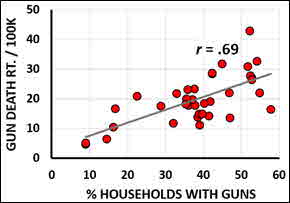 Problem is, firearms have great cultural significance. Our society’s attitudes about gun ownership and possession have inevitably led to their abundant (over-abundant?) presence. So half-steps – and that’s clearly all that many (most?) of our fellow-citizens seem willing to do – are unlikely to substantially lessen the mayhem. Our graph uses CDC data. While we don’t claim that gun density is the only “cause” of gun deaths, it clearly matters. A lot. Even when we “control” for our favorite evil-doer, poverty, the “r” only drops to .61. (For more, see “Policing Can’t Fix What Really Ails.”) Problem is, firearms have great cultural significance. Our society’s attitudes about gun ownership and possession have inevitably led to their abundant (over-abundant?) presence. So half-steps – and that’s clearly all that many (most?) of our fellow-citizens seem willing to do – are unlikely to substantially lessen the mayhem. Our graph uses CDC data. While we don’t claim that gun density is the only “cause” of gun deaths, it clearly matters. A lot. Even when we “control” for our favorite evil-doer, poverty, the “r” only drops to .61. (For more, see “Policing Can’t Fix What Really Ails.”)
Let’s close with a bit of self-plagiarism from “Our Never-Ending American Tragedy”:
Given the nature of our society and its body politic, tweaking the rules seems the only option. But even the hardiest legal response (e.g., California’s) has had at best only a limited effect. What would work – drastically shrinking the number of guns in citizen’s hands and sharply curtailing the lethality of what remains – seems well out of reach. We’re not Britannia! That’s why when it comes to gun control, Police Issues tends to despair. Yet there’s been some momentum. Hopefully the final chapter of Reasonable Americans v. Guns is yet to be written.
Couldn’t have said it better ourselves!
UPDATES (scroll)
6/23/25 A 16-year old gang member faces four murder counts after opening fire at a carnival in a Salt Lake City suburb. His admittedly intended target, an 18-year old rival gangster, was fatally wounded. But a pregnant woman and an infant she was pushing in a stroller were also killed, and two teens suffered non-fatal wounds. Prosecutors have asked that the shooter remain in custody.
6/11/25 In 2010 the Supreme Court’s landmark McDonald v. City of Chicago decision, which held that the 2nd. Amendment applies to States and localities, overruled the city’s ban on handguns. A new study just published in JAMA Pediatrics analyzed firearms deaths in children and adolescents post-McDonald. Its findings indicate that States which adopted more permissive laws went on to suffer an excess of “thousands” of child deaths from gunfire. Meanwhile California, Maryland, New York, and Rhode Island, which retained strict gun laws, actually enjoyed a decreased rate of children killed by gunfire.
6/2/25 Gunfire erupted during an early Sunday morning gathering in a North Carolina town. “At least eighty shots” were fired, killing one and wounding eleven. It happened during a house party that was being attended by “as many as 100 people,” including teens from local high schools. Its site was a seemingly upscale, reportedly placid neighborhood with large lots spanning acres.
5/23/25 An analysis of BJS data reveals that homicides of children, age 11 and younger, decreased from 720 in 2014 to 620 in 2023. But the number of homicides that were accomplished with firearms increased, from 150 in 2014 to 220 in 2023. Controlling for population size, homicide rates (/100,000 children, 11 and younger) fell from 1.48 in 2014 to 1.28 in 2023. On the average, the yearly decrease was 1.5%. But rates for child homicides with firearms increased from .30 to .46. For that group, the average yearly increase was 4.2%.
5/21/25 Twice as many minors are getting shot in New York City as during the pre-pandemic era. There are also twice as many shooters. So far this year 27 gunmen have been teens, compared with 16 during the same period in 2018. Most recently, on May 12, a schoolyard fight led to a shooting, and to the unintended killing of a 16-year old girl. Two ”kids” have been arrested for her murder: one is thirteen, the other is fourteen.
5/19/25 Two 9mm. Glock pistols, one with an obliterated serial number. And an unserialized 9mm. “ghost gun” with a 30-round magazine and a drop-in auto sear that enables full-auto fire, like a machinegun. That’s what Beltsville, MD police found in the residence where an 18-year old boy shot and killed the 16-year old friend whom he was visiting. According to the shooter, he thought the pistol was unloaded when he racked its slide. Kimaury Kamara has been charged with felony manslaughter and felony weapons violations. He faces up to thirty years imprisonment.
5/14/25 “At least 50 times.” That’s how often Bernalillo Co., NM deputies have been called to an Albuquerque-area residence over family issues. And most recently, in February, when two brothers who live there, ages 7 and 9, were playing with a loaded pistol that they refused to give up. A dramatic drone image shows deputies as they close in and take the lethal “toy” away. Social service agencies have been called in to help the family deal with its many problems.
A scientifically-drawn sample of 2,709 U.S. gun owners responded to a detailed questionnaire about their reasons for having firearms and their gun storage practices. Secure storage was
significantly more prevalent among gun owners whose primary motivator was sport or hunting. Persons who feared violence at home, in their neighborhoods or at work
were substantially more likely to keep their guns unsecured. And while about half of gun owners reported that their guns were kept “locked and
unloaded,” about two-thirds of gun owners said they could access their guns in less than a minute.
5/9/25 Last December 16th. Natalie Rupnow, 15, opened fire with a 9mm. pistol at a K-12 Christian school in Madison, Wisconsin, killing a teacher and a student and wounding six students. She then committed suicide. Rupnow, who was despondent over her parents’ divorce, was given the gun she used, and another, by her father Jeffrey. He told police that his daughter had severe mental issues and had purposely cut herself, forcing him to secure all the knives in their home. Jeffrey Rupnow was just criminally charged with giving access to a handgun by a minor. (See 12/17/24 update)
4/17/25 According to a news update, four students, ages 15-18, were shot at Wilmer-Hutchins High School on April 15th. None was critically wounded. A fifth student was hospitalized for anxiety. Tracy Denard Haynes Jr., the 17-year old suspect, surrendered to police. He apparently brought the gun in during the early afternoon when another student let him in through an unsecured door. Haynes promptly opened fire, shooting "indiscriminately."
4/16/25 Three high-school students, ages 15-18, were shot and a fourth was injured when a fellow student opened fire on the campus of Wilmer-Hutchins High School in Dallas, TX. None of the injuries are life-threatening. Police have the shooter in custody. Students must enter the school through metal detectors, so it’s thought that the student somehow acquired the gun later. According to a student, "We were in class. I heard like six shots and the teacher ran to the door and closed it and told us to hide in the corner." Last year, a student was shot in the leg at the same school.
4/14/25 Philadelphia murders are reportedly down. But shootings by youths have bucked a seemingly favorable trend. Between 2010-2024 223 juveniles were charged with murder. In 2010 the number was 26; by 2018 it was “only” three. But killings then rose, reaching a stunning 39 in 2022. That dropped to a still-considerable 26 in 2024, the same as in 2010. Charges in nonfatal shootings are way up; there were twice as many (49) last year as in 2010 (24). Among other things, authorities blame teens’ exposure to and glorification of violence, a lack of opportunities, and the ready availability of guns.
4/10/25 Two 16-year old teens, a 17-year old and an 18-year old are under arrest after an “illegal gun sale/robbery” at a townhouse complex in Spotsylvania County, Virginia devolved into a mass shooting. Two 18-year old men and a 20-year old were killed, and three others were wounded, including one of the 16-year old suspects. Witnesses reportedly saw the alleged shooters “walking down the street with ‘guns in their hands’” and said that the gunfire sounded “like a machinegun.”
4/9/25 A Spotsylvania County, Virginia third-grader reached into his backpack during class at Lee Hill Elementary School. That’s when the gun he brought from home accidentally fired. Fortunately, no one was hurt. His parents, 36 and 34, are charged with failing to secure the gun and of endangering the life of a child under fourteen. (Third-graders are about nine years old.) Parents are being reminded by the school district to inspect their childrens’ backpacks before they leave for school to insure that they only contain what’s appropriate.
4/4/25 In June 2024 police patrolling a residential neighborhood of Utica (NY) encountered two 13-year old boys matching the description of robbers who struck there on the preceding day. Bodycam video shows one boy running away, then turning around with a gun in his hands and pointing it in the officers’ direction. One officer tackled the youth; another opened fire, inflicting a fatal wound. The youth’s gun was a realistic duplicate of a Glock 17 pistol. But all it could fire were “pellets or bb’s”. On April 2, 2025 State Attorney General Letitia James said that the officer who fired the fatal shot will not be charged. Utica's Mayor and police chief announced that they were "pleased" with the AG's decision. Bodycam video
3/25/25 According to Stateline, CDC Wonder fatality data reveals that gun deaths for persons age 17 and younger were about 50 percent greater in 2023 (the most recent year available) than in 2019, when the surge began. Gunfire is the most frequent cause of death for youths, and particularly Black youths. Their 2023 per/100,000 gun homicide rate of 8.9 was far worse than the 1.8 rate for Hispanic youths and the 1.0 rate for White youths. Asian youths had the lowest rate, 0.5.
3/24/25 A Cook County, Illinois father is in jail facing charges of ex-con with a gun and child endangerment after his young boys, ages 5 and 8, misused a loaded pistol that he left on a nightstand. Derrick Taylor, 32, was reportedly awakened by gunfire and rushed the children outside, where neighbors called 911. Taylor’s older child suffered a fatal head wound; his brother is in good condition. Taylor wasn’t supposed to have a gun, as he was convicted of residential burglary in 2011.
3/17/25 On the one hand, the 11th. Circuit ruled 8-4 that Florida law that bars persons under 21 from buying long guns - it was enacted after the Marjorie Stoneman High School massacre - is Constitutional. On the other, Florida’s Attorney General announced that his office would not defend the statute should it be appealed to the Supreme Court. AG James Uthmeiert agrees with the NRA and other pro-gun groups that the law violates the Second Amendment. “Men and women old enough to fight and die for our country should be able to purchase firearms to defend themselves and their families,” he said.
3/10/25 On Friday evening, March 9, Newark PD Detective Joseph Azcona, 26, was shot and killed and his partner was wounded by a 14-year old boy who was wielding “an automatic weapon.” The officers were part of a joint local-Federal team that drove up to a group of youths who reportedly had illegal firearms. Return fire wounded the shooter. He was arrested and charged with murder and gun violations, and five companions were detained.
3/6/25 A recent journal article in Preventive Medicine, “Perceptions of neighborhood disorder and gun carrying during adolescence: The indirect effect of exposure to violence,” examines the reasons why adolescents bring guns to school. It concludes that while neighborhood disorder is an important factor, the exposure of violence is the most proximate cause. According to the authors, providing “mental health resources” would benefit youths who live in disorderly, violence-stricken neighborhoods.
1/31/25 Located in Louisiana, the Federal Fifth Circuit Court of Appeals has invalidated a host of Federal gun control measures, from prohibitions against “bump stocks” to laws that forbid drug users and persons under domestic violence restraining orders from acquiring guns. And now they’ve moved against the law that prohibits selling handguns to persons under 21. “Ultimately, the text of the Second Amendment includes eighteen-to-twenty-year-old individuals among 'the people' whose right to keep and bear arms is protected.” And the fight is on.
1/29/25 A 14-year-old D.C. youth “with a big smile” was shot dead by another 14-year old during a robbery spree by the killer and his two 16-year old brothers. Video surveillance depicts the shooting. It also shows the three robbers holding up other victims, then fleeing in a White Kia sedan. Their arsenal included a .40-caliber pistol, a 9mm. pistol, and “a Kalashnikov rifle in a duffel bag.”
1/23/25 A 17-year old male student at Nashville’s Antioch High School opened fire in the school cafeteria, killing a 16-year old female student. His gunfire also struck another student, inflicting a slight wound. School resource officers were in a different building, and by the time they arrived Solomon Henderson had committed suicide. In October 2024 the officers found a gun in another student’s pants. Antioch High School lacks metal detectors; the school superintendent indicates they’re being considered.
1/10/25 “I want to shoot up my school. I’ve been preparing for it for the past few months.” That’s how a former student at Maryland’s Wootton High School began a book he wrote last year. And that (among many other things) led a judge to convict 19-year old Alex Ye of making terroristic threats. Just like his novel’s main character, Ye’s “homicidal ideations” had once landed him in a psychiatric hospital. He now faces up to ten years in prison.
Keep going...
|
Did you enjoy this post? Be sure to explore the homepage and topical index!
Home Top Permalink Print/Save Feedback
RELATED WEBSITES
Washington Post School Shootings Database K-12 School Shooting Database Gun Violence Archive
School Shooting Safety Compendium Wikipedia list of school shootings
RELATED POSTS
Gun Massacres special topic
All in the Family (II) Prevention Through Preemption Policing Can’t Fix What Really Ails
Are We Helpless to Prevent Massacres? Our Never-Ending American Tragedy
Ban the Damned Things! Again, Kids Die. Again, Our Leaders Pretend.
Posted 4/9/24
IDEOLOGY (STILL) TRUMPS REASON
When it comes to gun laws, “Red” and “Blue” remain in the driver’s seat
For Police Issues by Julius (Jay) Wachtel. Vice-President Kamala Harris’ recent visit was an inevitable heart-churner. Scheduled for demolition, Florida’s Marjory Stoneman High School remains mostly as it was in February 2018 when a former student barged in and opened fire with an AR-15, murdering fourteen students and three employees and wounding more than a dozen others.
Speaking before an audience that included the victims’ families, Ms. Harris announced a new Federal initiative, the “National Extreme Risk Protection Order Resource Center.” Established in partnership with the Bloomberg School of Public Health, it will train law enforcement officers, prosecutors, judges, clinicians and other service providers in the proper use of extreme risk protection orders, i.e. “Red Flag” laws, which authorize the pre-emptive seizure of firearms from dangerous persons. Such as Nikolas Cruz, the deeply-troubled nineteen-year old shooter who had been expelled from Marjory Stoneman “for behavioral reasons” in the year preceding the massacre.
Click here for the complete collection of gun control essays
“Ban the Damned Things!” recounts Cruz’s ominous and extensive online history. Two years before his unspeakable deed, he posted photos of self-inflicted cuts and declared his intention to buy a gun. That led to a mental health referral. But a counselor cleared him, and the online ranting continued. Indeed, his intentions became so explicit (i.e., “Im going to be a professional school shooter”) that an Internet user warned the FBI about Cruz a mere month before the massacre. But nothing happened.
At the time, Florida lacked a “Red Flag” law. That quickly changed. Still, the version it adopted wasn’t a complete solution. It requires that law enforcement officers (not simply citizens or family members) file a petition in court, and a hearing and judicial order are required before guns can be seized. No shortcuts are permitted. In 2019 a Lakeland woman was arrested for burglary when she tried to turn in her estranged husband’s guns to police. He was in jail after purposely ramming her car while on the road, and she feared for her life.
Marjory Stoneman led to another tightening. Cruz legally bought his AR-15 from a dealer when he turned eighteen, the Federal minimum. So Florida raised the minimum age to buy long guns to twenty-one. But this January, by an “11-5 party-line vote” (with “Reds” in the majority), the criminal justice committee of Florida’s House chamber sent forward a measure that would restore the ability of eighteen-year olds to buy long guns. According to Rep. Bobby Payne (R-Palatka), doing so is “very important in my rural area. We do a lot of bird hunting.”
That reset is still pending. But what Florida’s political leaders are yet to do is define certain semi-automatic firearms like Cruz’s AR-15 as simply being too lethal. Guns labeled as “assault weapons” are presently banned in only ten States – California, Connecticut, Delaware, Hawaii, Illinois, Maryland, Massachusetts, New Jersey, New York and Washington. According to the National Conference of State Legislatures (NCSL), as of March 2024 each of these States is one of sixteen that are under complete control of the Democratic Party, meaning that both legislative Houses and the Governor are “Blue.” Republicans, in turn, exercise full control over twenty-three States. None of these “Red” states has an assault weapons law. Not one.
A telling partisan split extends well beyond assault weapons. Everytown For Gun Safety recently released its 2024 State gun-law-strength rankings. Their system assigns 1 to the State with the strongest overall gun laws, and 50 to the State with the weakest. We turned it around, creating a scale of gun law strength that ranges from 1-50, with 50 the strongest.
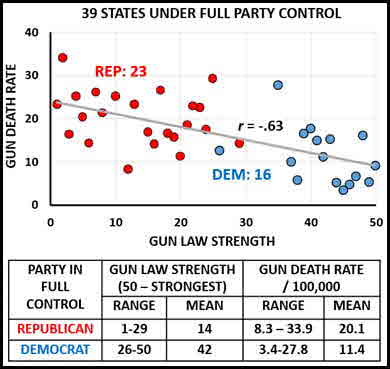
Colored dots – red for Republicans, blue for Democrats – represent the 39 States that are fully under control of a single party. According to the scattergram and table, there’s a strong relationship between NCSL party composition, Everytown gun law strength rankings and CDC 2021 firearm mortality death rates (it includes all deaths by gunfire, including crimes, accidents and suicides). Check the table. Mean gun law strength for “Blue” States is three times that of “Red” States, and the mean death rate is only half in magnitude. Notice how neatly the “Reds” and “Blues” cluster in the scattergram, with the “Reds” displaying consistently lower gun law strength scores and higher death rates than the “Blues”. Indeed, their gun law strength scores overlap only once, in the middle. To more precisely express the relationship between gun law strength and gun death rate we computed the r (correlation) statistic. It ranges from zero, meaning no relationship between variables, to plus or minus 1, meaning a perfect association. For this group of 39 States, gun law strength and gun death rate have a robust r of -.63. As one goes up or down, the other consistently follows, but in the opposite direction.
“Policing Can’t Fix What Really Ails”, our recent exploration of the role of poverty in crime, assessed relationships between poverty, household firearms ownership, violent crime, homicide and gun deaths. These scattergrams depict the results of a 50-State analysis which examines the role of Party composition (measured by proportion of State legislators who are Democrats) as a potential driving force:
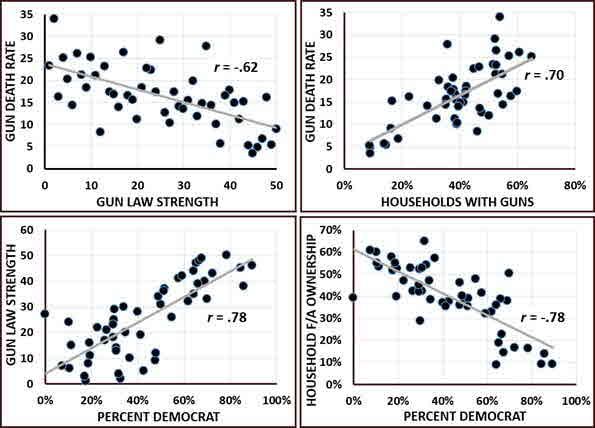
- Top left graph: Gun law strength and gun death rates have a robust r of -.62, virtually identical to what we computed for the 39-State sample. As one factor increases, the other decreases, and in close sync.
- Top right graph: At r= .70, the proportion of households with guns exhibits a strong relationship with gun deaths. Since we’re considering all manner of gun deaths, including accidents and suicides, that’s no surprise.
- Bottom left graph: To assess the potential influence of political parties on gun law strength, NCSL data was used to determine each State’s proportion of “Blue” legislators. Results are consistent with what we found for the 39-State sample. Political party and gun law strength share a strong relationship, producing an r of .78. That’s a “positive” relationship, meaning the variables go up and down together.
- Bottom right graph: An equally robust correlation, in the “negative” direction, characterizes the relationship between party preference and household gun ownership. As percent “Blues” goes up, gun ownership goes down, and in very close sync.
This matrix displays all the relationships:

Check out the bottom row. Gun death rates substantially increase with gun ownership (positive relationship) but markedly decline as percent Democrat and gun law strength increase (negative relationship). “Reds” support gun ownership and oppose gun lawmaking. And here’s how we figure things play out in the “real world”:

Given a reluctance, even in “Blue” places, to impose truly strict controls, guns have become ubiquitous throughout the land. According to NBC News’ latest poll, 52 percent of registered voters – the highest proportion ever – have at least one gun at home. Firearms ownership was reported by 66 percent of “Reds”, 45 percent of Indies and 41 percent of “Blues”.
While full-blooded “Red” States are more deeply affected by gun violence, they don’t suffer alone. Consider Virginia. Traditionally split down the middle politics-wise, it presently has two-member Democratic majorities in its State House and Senate. But Governor Glenn Youngkin is a “Red.” So he recently vetoed a host of gun control measures, including an assault-weapons ban, that had squeaked through on Party-line votes. He even turned away a prohibition on guns on college campuses that had been inspired by a November, 2022 shooting which took the lives of three University of Virginia students on a chartered bus. However, Gov. Youngkin did sign a bill requiring schools to remind parents of their responsibility to safely store guns. That tepidly-worded measure followed on a recent incident in which a six-year old first-grader used an unsecured gun to shoot his teacher. (His mother just pled guilty to child neglect.)
Switch to deep-Blue. Consider the recent tragedy in California, where a 10-year old used a gun he “stole” from his father’s car to shoot and kill another child. And the 66-year old upstate New York homeowner who opened fire on vehicles that (mistakenly) drove up his driveway, killing one of the occupants. He just drew 25-to-life. (For many more such examples scroll through the “Updates” sections of our essays in Gun Control 2023.)
Clashing ideologies aside, firearms ownership remains commonplace throughout the land. “Reds” argue that firearms are vital for protection, and many “Blues” agree. It turns out that their supposedly more “stringent” gun laws are riddled with exceptions. Such as California’s assault weapons “ban”, which allows semi-automatic rifles that, other than for a ten-round limit, are the functional equivalents of the highly lethal AR-15.
So how are the risks of violence dispersed? These graphs report mean State crime rates from the UCR, mean firearms mortality and suicide data from the CDC, and State poverty data from the Census:
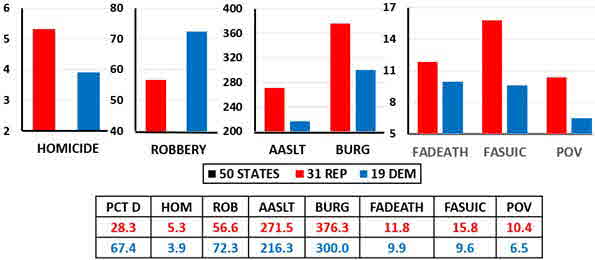
“Red” States suffer from higher homicide, aggravated assault and burglary rates, while “Blue” States have higher robbery rates. Residents of “Red” States seem at somewhat higher risk of crime, but the picture is mixed. What’s perfectly clear is that “Red” States contend with substantially higher rates of firearms death and firearms suicide. Given their elevated rates of gun ownership, that would seem all-too predictable.
However, their residents’ increased risk of death isn’t something that seemingly concerns “Red” politicians. Say, Indiana Governor Eric Holcomb (his State is eleventh “Reddest”, with a legislature under full “Red” control). Gary, one of the State’s few “Blue” places, had a long-running lawsuit against the gun industry, which it blamed for fomenting violence. A judge recently gave it some steam. So legislators sent on, and Governor Holcomb quickly signed, a bill that prohibits cities from doing such things. And its effect is retroactive. Sorry, Gary!
Be sure to check out our homepage and sign up for our newsletter
Of course, the effects of partisanship go well beyond the gun debate. As we discussed in “Judicial Detachment: Myth or Reality?” ideological notions have long shaped key rulings by our vaunted Supreme Court. (Its “Reds” are presently in the driver’s seat with a one-vote advantage.) Bottom line: when it comes to critical public issues, informed, objective analysis is often elbowed aside by the unholy influences of political ideology, both “Red” and “Blue”. That’s what is truly scary.
UPDATES (scroll)
4/4/25 Federal law (18 USC 425[c]) authorizes persons who are barred from having guns by prior felony convictions or other reasons to petition to have their rights restored. But in 1992 Congress defunded ATF’s processing of applications for “relief from disabilities.” In a new move prompted by the President's championing of the Second Amendment, DOJ itself has taken on that task. Attorney General Pam Bondi presently has ten applicants on tap to receive relief. One is actor Mel Gibson, who pled guilty in 2011 to battery on his then-girlfriend. His application had been turned away by the former Pardon Attorney, but she was fired.
3/28/25 Concerns that the L.A. County Sheriff’s Dept. is “depriving ordinary, law-abiding Californians of their Second Amendment rights” by imposing unseemly delays in processing CCW license permits has led DOJ’s Civil Rights Division to launch a patterns-or-practices inquiry. It’s based, in part, on a recent Federal court decision that blasted the year-and-a-half delays endured by two applicants. Like burdens, DOJ announced, are common throughout California, where cities impose “expensive fees and lengthy weight times” well beyond what’s required by state law.
10/16/24 According to a noted gun-law analyst, the Supreme Court’s landmark Bruen decision fundamentally reshaped the gun-law landscape. Still, the Court just reinstated, at least for the time being, a Pennsylvania law that bars persons under 21 from carrying guns during declared emergencies. But consequential decisions about “ghost guns,” gun possession by felons and “Red Flag” laws are still in the offing.
8/16/24 Texas State Fairgrounds occupy an expansive plot of central Dallas. After a shooting last year that wounded three and forced an evacuation, organizers are now banning guns altogether. In a State that proudly permits unlicensed gun carry, that’s caused a great deal of upset. Arguing that the move actually imperils safety, “Red” lawmakers demand a reset. But Fair officials point out that other public gatherings have similar rules, and that 200 police officers and safety personnel will be on patrol.
8/2/24 Citing its purported conflict with the Supreme Court’s Bruen decision, New Jersey U.S. District Judge Peter Sheridan ruled the state’s ban on AR-15 rifles unconstitutional. However, he allowed its ban on magazines that hold more than ten rounds to remain in effect. He stayed his ruling for thirty days while the firearms advocates who pressed the lawsuit and the State file their anticipated appeals.
7/16/24 The FBI defines “active shooter incidents” as “one or more individuals actively engaged in killing or attempting to kill people in a populated area.” In 2023 forty-eight active shooter incidents took place across twenty-six states, killing 105 persons and wounding 139. California had the most - eight. Runner-ups Texas and Washington state each had four. There were fifty active shootings in 2022, killing 100 persons and wounding 213. Five-year comparisons indicate a substantial increase. There were 229 during 2019-2023. That’s 89 percent more than the 121 active shootings during 2014-2018.
7/8/24 Twenty-nine States allow individuals otherwise entitled to have guns to carry concealed firearms without a permit. Louisiana, the most recent “permitless carry” State, came aboard July 4th. That drove New Orleans P.D. Supt. Anne Kirkpatrick to designate the French Quarter’s police station as a “vocational training school”, since it’s used for officer training. Doing so activates a State law that forbids concealed carry within 1,000 feet of a school or training site. Legislators had refused to exempt New Orleans or the French Quarter from the new law, and they’re wary of the Superintendent’s move.
|
Did you enjoy this post? Be sure to explore the homepage and topical index!
Home Top Permalink Print/Save Feedback
RELATED POSTS
Gun Massacres special topic
Gun Control? What’s That? Who’s Under the Gun? The FBI, That’s Whom
Ideology Trumps Reason Does Legal Pot Drive Violence? Fearful, Angry, Fuzzy-Headed. And Armed
“Legal” Gun Buyers Can be a Problem Loopholes are (Still) Lethal Policing Can’t Fix What Really Ails
Judicial Detachment: Myth or Reality? Cops v. Assault Weapons Ban the Damned Things!
Red Flag at Half-Mast (I)
Posted 2/28/24
HOUSTON, WE HAVE (ANOTHER) PROBLEM
Fueled by assault rifles, “senseless” murders plague the land
For Police Issues by Julius (Jay) Wachtel. As our more “senior” readers know, the “problem” we’re appropriating for our own, selfish purposes reared its ugly head fifty-four years ago. On April 14, 1970, an American mission to the moon was aborted mid-flight when an oxygen tank blew up. Happily, the orbiter landed safely (on Earth) and no one got hurt.
Like all such missions, Apollo 13 launched from Florida’s Cape Kennedy. It then came under the control of “Mission Control” at Johnson Space Center, a vast “$1.5 billion complex” near downtown Houston. That’s Houston, Texas. Our government’s most sophisticated, science-based enterprise is based in a decidedly “Red” State. Texas also happens to be a “Stand Your Ground” State. Meaning, among other things, that it encourages private gun ownership. And, apparently, gun use. For example, its denizens are under no obligation to retreat before using force, including deadly force, in self-defense (Texas Penal Code sec. 9.31e).
Click here for the complete collection of gun control essays
Our focus here, though, isn’t on simple errors in judgment, no matter how tragic their consequences. After all, even the best-intentioned humans (and here we include most cops) occasionally fall prey to the chaos and uncertainty that suffuse everyday life. It’s about “senseless” behavior, meaning without any rational basis. And there are few better examples than what happened in Houston during the afternoon hours of Sunday, February 11. That’s when a local resident, 36-year old Genesse Ivonne Moreno, burst into a church between services. Accompanied by her 7-year old son, Moreno was attired in a trench coat and carried two rifles, a .22 caliber weapon and an AR-15. She quickly opened fire with the latter in a hallway. Two off-duty police officers working security promptly fired back, killing her. During the exchange Moreno’s son was critically hurt, and a middle-aged parishioner sustained non-life threatening wounds to his leg. (Just whose bullets struck them is yet to be revealed.)
What drove Moreno to act as she did? Her rifle bore a “Palestine” sticker, and she had reportedly made “anti-Semitic” writings. But the church was a Christian congregation. Motives aside, what is known paints a highly disturbing picture of a highly disturbed soul. While Moreno identified as a woman, she had a substantial criminal record in Houston under a male alias. Here’s a summary from our inquiry of the Harris County Court:

Moreno supposedly purchased the AR-15 in December 2023. How, and from whom, hasn’t been revealed. She has no known felony convictions, which would have barred her from buying a gun from a dealer. Family members and police said that Moreno suffered from long-standing mental problems; police officers placed her under “emergency mental detention” in 2016. However, Texas doesn’t have a “Red Flag” law, so there was no ready way to keep her from buying a gun in a store. Neither does it require background checks for gun transfers between private parties. So Moreno could have easily acquired a firearm even if her mental problems were of record.
Moreno hasn’t been the Lone Star State’s only “senseless” killer. Consider the May 6, 2023 massacre in Allen, a Dallas exurb. Attired in tactical gear and wearing an “RWDS” (Right-Wing Death Squad) patch on his chest, Mauricio Garcia, 36, jumped out of his car and began “indiscriminately” firing an AR-15 in the parking lot of a large mall. He then charged into a building and continued the fusillade. Garcia killed eight and wounded seven before a security guard shot him dead.
 Garcia (photo from OK.ru) brought along an arsenal. In addition to the AR-15 he carried two handguns on his person and had five more guns in his car. All were legally bought. Garcia, a security guard, had a clean criminal record. But there was a “glitch”. Garcia enlisted in the U.S. Army when he was eighteen. But only three months later concerns about his mental health and an “adjustment disorder” led to his discharge. Unfortunately, the Army didn’t pass that on to the FBI, which runs the nation’s “Insta-Check” gun purchase system. So he remained free to buy guns from retail dealers to his wicked heart’s delight. Garcia (photo from OK.ru) brought along an arsenal. In addition to the AR-15 he carried two handguns on his person and had five more guns in his car. All were legally bought. Garcia, a security guard, had a clean criminal record. But there was a “glitch”. Garcia enlisted in the U.S. Army when he was eighteen. But only three months later concerns about his mental health and an “adjustment disorder” led to his discharge. Unfortunately, the Army didn’t pass that on to the FBI, which runs the nation’s “Insta-Check” gun purchase system. So he remained free to buy guns from retail dealers to his wicked heart’s delight.
We’re not done with Texas. Four days preceding Garcia’s foul deed a tactical unit comprised of Feds and State troopers arrested Francisco Oropeza in the small town of Cut and Shoot, about 40 miles north of Houston. Oropeza was on the run after murdering four adults and a 9-year old in the nearby town of Cleveland, where he lived, because they had the temerity to demand that he stop shooting his AR-15 in his yard. One of his victims had just called 9-1-1 about his gunfire. And this wasn’t the first time.
Oropeza was an illegal immigrant with four prior deportations. That’s important to know because it legally excluded him from having guns. Prosecutors are seeking the death penalty. Sadly, that’s already been imposed.
“We can't get inside his head. We just don't have any clue as to why he did what he did.” Joliet Police Chief Bill Evans’s comments reflect the perplexing nature of the January 21, 2024 spree by our fourth killer, twenty-three year old Romeo Nance. He was ultimately cornered – and committed suicide – in Texas. But his appalling handiwork took place in Joliet, Illinois, the community where he grew up. And its toll was grim. Nance murdered his mother, three sisters, a brother, and an uncle and aunt. While fleeing he also shot and killed a 28-year old pedestrian carrying groceries and wounded a middle-aged man whom he happened to encounter.
Nance’s explosive temper was well known to police, who were frequently summoned to his residence. Leaving out numerous traffic infractions, here’s a summary of his adult criminal record from the Will County Court:
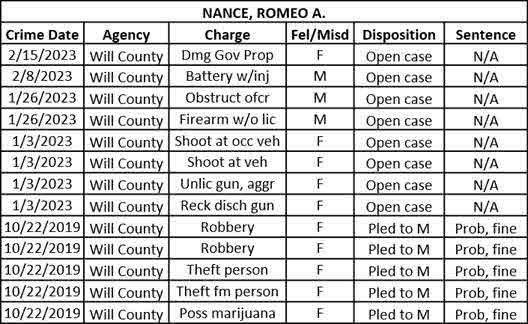
Soon after turning eighteen Nance was arrested for a robbery that involved “pressing a knife against [his victim’s] chest”. He got a break, and the case was settled with his plea to a misdemeanor marijuana charge. Nance completed a probationary term, by all appearances successfully. But his conduct eventually tanked. In January 2023 he shot at a female motorist during a traffic encounter. Police seized an unlicensed handgun and “two cartons of ammunition” from his backpack. Nance went on to assault an officer and soon collected additional charges.
Nance perpetrated his massacre using an “AR-15 style” rifle that was recovered from his car. He also used a handgun. How he obtained these weapons hasn’t been revealed. His previous tangles made him ineligible to receive an Illinois firearm owner’s ID card, which the State requires of all gun owners. So he probably acquired his guns through private transactions.
Shift to Minnesota. Prohibited or not, emotionally-troubled men – and it’s almost always a male – find it easy to get high-powered firearms. On February 18, 2024, after a prolonged negotiation session during which he denied being armed, Shannon Gooden unleashed a barrage of “more than 100” rifle rounds, killing two Burnsville police officers and a paramedic who had responded to a call about a sexual assault. Despite a 2007 felony assault conviction and a judge’s 2020 refusal to reinstate his gun rights, Gooden had multiple firearms and a copious amount of ammunition. He committed suicide
Switch to Maine. U.S. Army reservist Robert Card’s mounting “anger and paranoia” deeply troubled an Army chum. So much so, that in September 2023 he warned their superior that Card was going “to snap and do a mass shooting.” And on October 25 that’s exactly what he did, unleashing back-to-back barrages in a Lewiston bowling alley and a restaurant (surveillance photo on right) that killed eighteen persons and injured thirteen. Card had a troubled mental history. It included a two-week 2023 stint in an Army psychiatric ward that followed his mentions of “hearing voices” about “hurting other soldiers”. But the Army, which barred him from handling guns, apparently didn’t consider his treatment to be a mental “commitment” that required it inform the Insta-Check system. Ergo, Card remained able to buy guns to his wicked heart’s delight. Including the Ruger SFAR semi-auto rifle he used in the massacre. And yes, he bought it in a gun store. Ten days earlier. Card committed suicide as police closed in. “anger and paranoia” deeply troubled an Army chum. So much so, that in September 2023 he warned their superior that Card was going “to snap and do a mass shooting.” And on October 25 that’s exactly what he did, unleashing back-to-back barrages in a Lewiston bowling alley and a restaurant (surveillance photo on right) that killed eighteen persons and injured thirteen. Card had a troubled mental history. It included a two-week 2023 stint in an Army psychiatric ward that followed his mentions of “hearing voices” about “hurting other soldiers”. But the Army, which barred him from handling guns, apparently didn’t consider his treatment to be a mental “commitment” that required it inform the Insta-Check system. Ergo, Card remained able to buy guns to his wicked heart’s delight. Including the Ruger SFAR semi-auto rifle he used in the massacre. And yes, he bought it in a gun store. Ten days earlier. Card committed suicide as police closed in.
We began our post by declaring a focus on “senselessness”. Alas, irrational behavior is not uncommon. And in our gun-infused society, it all-too-often leads to gunplay. Most, though, involves handguns. As we pointed out in “Going Ballistic,” their lethality is far, far outstripped by the killing power of the military-style rifles that have become immensely popular among enthusiasts. And mass murderers. Let’s self-plagiarize from our 2015 op-ed in the Washington Post:
One assumes that assault rifles were picked on [by the Federal ban] because they are particularly lethal. Key attributes that make them so include accuracy at range, rapid-fire capability and, most importantly, fearsome ballistics. In their most common calibers – 7.62 and .223 – these weapons discharge bullets whose extreme energy and velocity readily pierce protective garments commonly worn by police, opening cavities in flesh many times the diameter of the projectile and causing devastating wounds.
All this is well known to law enforcement. Between 2010-2019 (the last year with complete LEOKA data) 471 law enforcement officers were feloniously slain by gunfire. Of these, 339 were wearing body armor. And 21 were slain by rounds that penetrated their armor. This graph depicts the most frequent culprits, gun-wise:
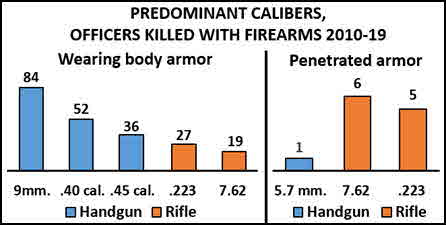
Ballistics definitely “count”. According to a March 2023 article in the Texas Tribune, that vulnerability was apparently very much on the minds of the officers who responded to the May 2022 massacre at Robb Elementary School in Uvalde, Texas. During “previously unreleased interviews” they said they backed off and waited for SWAT because they lacked the weapons and protective gear to confront the shooter’s “battle rifle”. Here’s its image when seized:

Several non-SWAT officers did try to make a prompt approach. As they went down the hallway the gunman opened fire through a door. Two officers got grazed:
The gunman had an AR-15…Its bullets flew toward the officers at three times the speed of sound and could have pierced their body armor like a hole punch through paper. They grazed two officers in the head, and the group retreated.
According to a police sergeant, “You knew that it was definitely an AR. There was no way of going in.”
When it came time to review the police response, political correctness took hold. Official assessments (click here for DOJ’s report) repeatedly blasted the (again, non-SWAT) cops for not promptly charging in . No mention was made of the exceptionally lethal nature of Ramos’ gun, whose projectiles would readily defeat “ordinary” ballistic vests commonly worn on patrol. Of course, Texas is a place that embraces guns. Suggesting that so-called “assault rifles” are simply too lethal would have stirred a hornet’s nest. Far better (and safer) to blame it on the cops, and only the cops.
Then came the Allen massacre. Attention turned to a Texas House bill, backed by the families of Uvalde’s victims, that would have increased the minimum age for buying semi-auto rifles from 18 to 21 (Uvalde’s gunman was 18 when he bought his two AR-15 style rifles from a dealer.) That seems hardly controversial. Even so, gunplay had abated, and the proposal quickly died in committee. Really, in Texas it simply can't be about the gun. Here’s what the legal counsel for Texas Gun Rights told the Washington Post about the massacre in Cleveland, Texas:
It’s a tragedy but we need to get away from blaming guns which only answers the question of how and start asking the question why these shootings take place, why people feel the need to settle differences with violence and murder…
But didn’t Francisco Oropeza’s AR-15 style weapon pose a special threat? Absolutely not, the lawyer replied. Its presence was “meaningless.” After all, Oropeza “could have killed those people just as easily with a handgun.”
In a recent interview, ATF Director Steven Dettelbach suggested that the unending stream of mass killings may be numbing Americans to the effects of gun violence. At a meet with families of the Lewiston massacre, he emphasized that speaking out was crucial. “Your voices are very important...It really makes a difference.” Dettelbach later told reporters that it was “too easy” for unstable persons to get firearms.
Be sure to check out our homepage and sign up for our newsletter
As a (long retired) ATF agent, we second the current boss’s views. Still, guns have suffused the land. They’re so easy to acquire from private sources that trying to control who gets them can seem hopeless. Perhaps a highly focused approach on the most lethal weapons – say, an outright prohibition on assault rifles – could help. After all, these instruments of war weren't in play when they penned the Second Amendment. Indeed, we urged that “solution” six years ago in “Ban the Damned Things!” Mind you, it would have to be a real ban, sans the exceptions and workarounds that characterize so-called “assault weapons bans” in so-called “strong law” States like our own California.
But for that, check out “A Ban in Name Only”. Meanwhile, has anything here resonated? If so, pass it on!
UPDATES (scroll)
6/19/25 Texas legislators have sent on a number of bills that would loosen up the State’s already-permissive gun laws. Orders to strip defendants of their guns (i.e., Red Flag Laws) would be barred in civil cases. Short-barreled firearms, including those illegal under Federal law, would become legal under State law. Law enforcement agencies would be barred from participating in gun buyback programs. And while handgun carry is generally legal in Texas, permits that allow guns to be carried in restricted areas would be easier to get.
5/6/25 Gunplay continues to beset the land. During the early morning hours of Sunday, May 4, “an uninvited guest” who was asked to leave a large Sweet 16 party being held in a Houston neighborhood started shooting. His gunfire was returned. In all, sixteen guests ages 16-40 were wounded; one, an 18-year old, was killed. About the same time, in the Phoenix area, a dispute between warring factions attending a concert and car show devolved into a shootout. Three persons, ages 17-21, were killed; five others, ages 16-23, were wounded.
8/21/24 “A series of failures by unit leadership.” According to a special commission investigating the October 2023 Lewiston, Maine massacre, that’s what enabled Army reservist Robert Card to keep buying guns despite his hospitalization for mental problems. Worse still, only a month before the massacre, a fellow reservist texted his superiors: “I believe [Card’s] going to snap and do a mass shooting.” A Maine sheriff’s official who learned of Card’s hospital stay and of the subsequent warning was also criticized for failing to invoke the state’s Yellow Flag law.
4/29/24 Military reservists told a commission investigating the October 2023 mass shooting at a Lewiston, Maine bowling alley that they were “surprised” when the shooter, reservist Robert Card, was released after spending only two weeks in a psychiatric ward. A close chum, Sean Hodgson, said that he warned leaders to change the code for entering the military base “and arm themselves if Robert Card showed up.” But his accounts of Card’s delusions, propensity for violence and access to guns were ignored. Hodgson, though, suffers from PTSD and alcohol problems, and his commander cautioned that his warnings “should be taken with a grain of salt.”
4/18/24 Inspired by the Lewiston mass shooting, Maine’s legislature approved a “sweeping” gun-control bill that imposes a 72-hour wait on gun purchases, bans bump stocks, requires criminal record checks for private gun sales, and makes it a crime to “recklessly” transfer a gun to a prohibited person. But while the State’s “Yellow Flag” law was strengthened, a proposed “Red Flag” measure that would allow family members (not just police) to petition for gun seizures was not included.
3/18/24 Maine has a “Yellow Flag” law that allows authorities to request that a judge order dangerous persons to give up their guns. According to a commission investigating the October 2023 massacre in a Lewiston bowling alley, where eighteen were shot dead, it could have been applied to its perpetrator, Army reservist Robert Card, well in advance. But a deputy who knew five weeks earlier that Card was in a “mental health crisis” and had threatened to commit a mass shooting did...nothing.
|
Did you enjoy this post? Be sure to explore the homepage and topical index!
Home Top Permalink Print/Save Feedback
RELATED POSTS
Gun Massacres special topic
“Legal” Gun Buyers Can be a Problem Fearful, Angry, Fuzzy-Headed. And Armed.
Are We Helpless to Prevent Massacres? An American Tragedy Loopholes Are (Still) Lethal
Cops v. Assault Weapons Going Ballistic Red Flag at Half-Mast (I) (II) Ban the Damned Things!
A “Ban” in Name Only A Stitch in Time
|